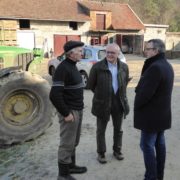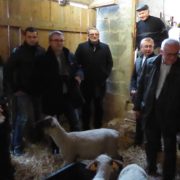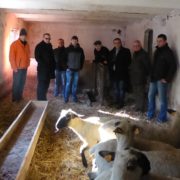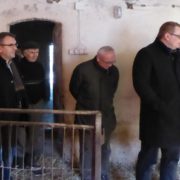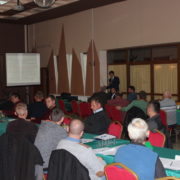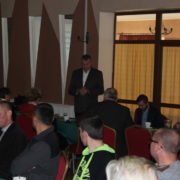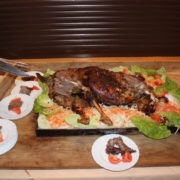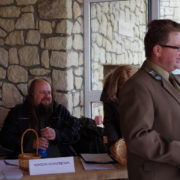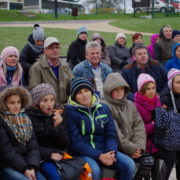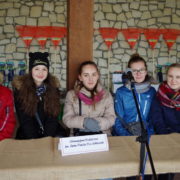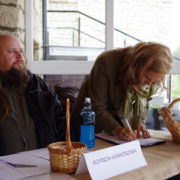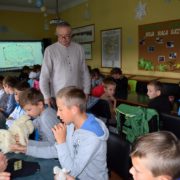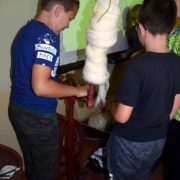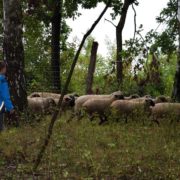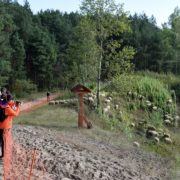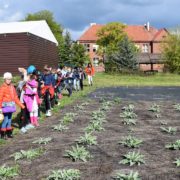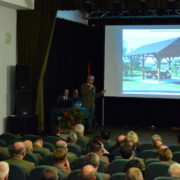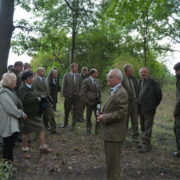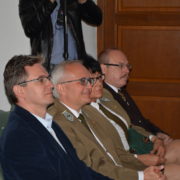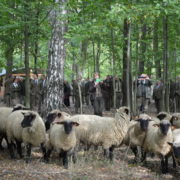Dominik
The end of the pasturing season
Michał Dobaj’s farm, which we visited during the symbolic ending of the pasturing season, is one of the six farms working with the Landscape Park Complex of the Świętokrzyskie and Nadnidziańskie Region on carrying out the LIFE+ project “The protection of xerothermic grasslands at the Ponidzie region”. The sheep, which were working on the grasslands for the whole summer as natural mowers, have already returned to the sheepfold for winter. The first pasturing season has ended. We are waiting for the birth of lambs, which will set off to the pastures near the Nida River in the spring. The presence of a member of the Management Board of the Świętokrzyskie Region, Piotr Żołądek, and several breeders was an opportunity to discuss the possibilities of sheep breeding development at the Ponidzie region.
Sheep pasturing on the grasslands have already become a tourist attraction. This ecological and extensive breeding model, and the increase of the headage of the flocks in the future, will result in lamb production. Lamb has extraordinary dietary values due to the content of polyunsaturated fatty acids as well as orotic acid and linoleic acids, which are strong antioxidants. In the future, lamb dishes can become a distinctive feature and an attraction of the Ponidzie region in the same way as the St Anne’s Chapel or the Wielopolski Palace in Chroberz.
Training for shepherds organized by the Świętokrzyski Agricultural Extension Centre (ŚODR) in Modliszewice
All the six breeders working with us on the project regarding the protection of xerothermic grasslands participated in the training for shepherds organized by ŚODR in Modliszewice. For two days (October 25th and 26th), we could make ourselves familiar with “Innovative methods of breeding small ruminants”. The title of the conference fully reflected the subjects of the lectures given by scientists from the University of Agriculture in Cracow, University of Life Sciences in Lublin and representatives of the National Veterinary Inspectorate and ŚODR in Modliszewice. The training included everything the breeder could be interested in; from the construction of the sheepfold and modern technologies of the flock expansion, through the methods of feeding and breeding so as to achieve the best possible breeding results, and in the end financial results too.
A lecture on the nutritional values of milk and sheep’s meat was an opportunity to discuss the necessity of promoting lamb and using it more frequently in our menu. This meat is considered to be functional food, recommended particularly for small children, pregnant women and elderly people, as well as for convalescents. Lamb has the least cholesterol content of any meats, contains the most polyunsaturated fatty acids, and it also contains conjugated linoleic acid (CLA) stimulating the immune system. This is probably why sheep do not have cancer. The values of sheep’s meat are improved thanks to pasture feeding, i.e. what we we carry out on our xerothermic grasslands. Perhaps soon we will have a regional dish like “a leg of blackhead lamb”, which will be an additional attraction of the Ponidzie region.
Szkolenie dla owczarzy zorganizowane przez Świętokrzyski Ośrodek Doradztwa Rolniczego w Modliszewicach
Cała szóstka hodowców współpracujących z nami w ramach projektu ochrony muraw kserotermicznych wzięła udział w szkoleniu dla owczarzy zorganizowanym przez ŚODR w Modliszewicach. Przez dwa dni (25 i 26 października) mogliśmy zapoznawać się „Innowacyjnymi metodami chowu małych przeżuwaczy”. Tytuł konferencji oddaje w pełni tematykę wykładów prowadzonych przez naukowców z Uniwersytetu Rolniczego w Krakowie, Uniwersytetu Przyrodniczego w Lublinie oraz przedstawicieli Państwowej Inspekcji Weterynaryjnej i ŚODR w Modliszewicach. Zakres szkolenia obejmował wszystko co może zainteresować hodowcę – od budowy owczarni i nowoczesnych technologii powiększania stada, przez sposoby żywienia i hodowli – tak aby uzyskać jak najlepsze wyniki hodowlane, a w efekcie i finansowe.
Wykład o walorach odżywczych mleka i mięsa owczego był okazją do dyskusji o konieczności promocji i szerszego wprowadzenia do naszego jadłospisu jagnięciny. Jest to mięso uważane za żywność funkcjonalną wskazane szczególnie dla małych dzieci, kobiet w ciąży oraz osób starszych i rekonwalescentów. Jagnięcina ma najmniejszą wśród mięs zawartość cholesterolu, zawiera najwięcej wielonienasyconych kwasów tłuszczowych, a ponadto zawiera sprzężony kwas linolowy (SKL/CLA) stymulujący układ odpornościowy. Zapewne dlatego owce nie zapadają na choroby nowotworowe. Walory mięsa owczego poprawiają się dzięki żywieniu pastwiskowemu, czyli takiemu jakie prowadzimy na naszych murawach kserotermicznych.
Być może w niedługim czasie doczekamy się regionalnej potrawy „udziec jagnięcy czarnogłówki”, co będzie dodatkową atrakcją Ponidzia.
A contest in Kije
The final of the contest organized by the employees of the Life+ project together with the Local Government Institution of Culture Kasztelania in Kije was held on Sunday, 16 October 2016, at the Kasztelania complex.
The middle school pupils from Sobków, Michałów and the home team took part in the competition. The members of the jury were Dr. Wojciech Szymański, the author of the questions, Magdalena Skrzypek, and Dariusz Wiech.
In the two-stage contest, the participants first had to describe one of the drawn plants and then answered short, previously drawn questions. The pupils from Michałów and Sobków showed particularly good knowledge. In the end, the pupils from Michałów turned out to be a bit better, outdistancing the Sobków team.
The home team took the third place, and they said they would try to win in the following year.
All the teams received valuable prizes, which were gardener sets. The contest was ended with a bonding meeting with hot tea and delicious żurek (soup made from fermented rye flour) cooked with the use of wild growing plants. The happy pupils said goodbye exclaiming: “See you next year”.
Konkurs w Kijach
Finał konkursu organizowanego przez pracowników projektu Life+ wspólnie z Samorządową Instytucją Kultury Kasztelania w Kijach odbył się w niedzielę 16.10.2016 na obiektach Kasztelanii.
W rywalizacji wzięli udział gimnazjaliści z Sobkowa, Michałowa oraz gospodarze. W jury zasiedli:
Dr Wojciech Szymański – autor pytań – oraz Magdalena Skrzypek i Dariusz Wiech.
W dwuetapowym konkursie najpierw opisywano jedną z wylosowanych roślin a następnie
odpowiadano na krótkie ,wcześniej wylosowane pytania. Znakomitą wiedzą wykazali się szczególnie uczniowie z Michałowa i Sobkowa. Ostatecznie minimalnie lepsi okazali się gimnazjaliści z Michałowa wyprzedzając Sobków.
Gospodarze zajęli trzecie miejsce zapowiadając, że w przyszłym roku postarają się wygrać.
Wszystkie drużyny otrzymały cenne nagrody – zestawy ogrodnika. Konkurs zakończyło spotkanie integracyjne przy gorącej herbacie i smacznym żurku gotowanym ,a jakże, z wykorzystaniem roślin dziko rosnących. Roześmiani gimnazjaliści pożegnali się słowami – ’’ do zobaczenia za rok’’.
A preventive patrol
On Thursday, October 13th, after a few rainy days, it cleared up a bit and we could go out on patrol in the western part of Garb Pińczowski, which had been planned for several weeks. This time we were accompanied by a group from the Youth Fostering Centre in Chęciny. It was cloudy, cold and windy, but the Nida valley was quite well visible, and we could also watch kestrels circling near the Skowronno reserve, through binoculars. The participants had an opportunity to listen to a short lecture on the geology and biology of the region, but picking splendid wild mushrooms on our way was even more attractive. We did not find any illegal rubbish dumps, and after going down to Brzeście, the patrol was ended with a bonfire at the ZŚiNPK premises in Krzyżanowice.
An educational workshop
For the fourth time already, we organized a series of educational workshops for children and teenagers. For five days young people from 12 educational institutions, more than 200 people altogether, had a good opportunity to learn about the goals and realization of our project, this time under the following banner: “Sheep and goats grazing, or the protection of valuable natural habitats at Ponidzie” (“Owce i kozy na wypasie czyli ochrona cennych siedlisk przyrodniczych na Ponidziu”). The classes also included field activities, which was visiting two habitats: xerothermic grasslands at the Serpentyna site, in the closed quarry at the area of Garb Pińczowski, and in the Quercetalia pubescenti-petraeae areas in Młodzawy. Then the participants of the workshop went to the headquarters of the Landscape Park Complex of the Świętokrzyskie and Nadnidziańskie Region in Krzyżanowice to listen to a talk about the geological structure of the Nida Basin, and about customs related to sheep breeding and benefits of this. They could try their hands at spinning threads from wool, weaving on bardko (the simplest loom), or making pompons by themselves. Thanks to this, they could appreciate skills and patience needed to weave a rug or knit a sweater. This practical knowledge had once been common and necessary to live, but today, unfortunately, it is becoming forgotten. The Krzyżanowice workshop was a great opportunity to recollect it.
A meeting of foresters in Pińczów
The conference dedicated to the protection of valuable natural habitats located within the area of the Regional Directorate of National Forests, organized by the Świętokrzyskie and Radom branch of the Polish Forest Association, together with our institution, was held last Thursday in Pińczów. One of the four lecturers was our director, Mr Tomasz Hałatkiewicz, who talked about the active protection of valuable natural habitats, using an example of our Life+ project. An important item on the conference programme was a trip to the forest of the Forest Inspectorate of Pińczów, to the place where we are carrying out a program of the protection of Quercetalia pubescenti-petraeae areas, together with the Forest Inspectorate. The participants could see the effectiveness of the protective measures carried out there. This part of the conference, as well as a coach trip along the area of Garb Pińczowski, where the effects of our sheep’s work were also watched, was conducted by Mr Hałatkiewicz. The organization of the meeting of Świętokrzyskie foresters proved that we were a professional team that could rise to the challenge, which was emphasized by the forests and guests of the conference as they were leaving Pińczów, including Marshal Adam Jarubas and poet Adam Ochwanowski, one of the authors of “Ponidzie on earth” (“Ponidzie na ziemi”) diaporama, the presentation of which was the first item of the meeting in Pińczów.
Spotkanie leśników w Pińczowie.
Konferencja poświęcona ochronie cennych przyrodniczo siedlisk znajdujących się na terenie Regionalnej Dyrekcji Lasów Państwowych, zorganizowana przez Świętokrzysko-Radomski oddział Polskiego Towarzystwa Leśnego wspólnie z naszą instytucją odbyła się w ostatni czwartek w Pińczowie. Jednym z czterech wykładowców był dyrektor Tomasz Hałatkiewicz, który mówił o ochronie czynnej cennych siedlisk przyrodniczych na przykładzie naszego projektu Life+.Ważnym punktem konferencji była wycieczka do lasów Nadleśnictwa Pińczów w miejsce, gdzie wspólnie z Nadleśnictwem realizujemy program ochrony świetlistych dąbrów. Uczestnicy mogli w terenie przekonać się o skuteczności prowadzonych zabiegów ochronnych. Tę część konferencji jak również wycieczkę autokarową wzdłuż Garbu Pińczowskiego, gdzie również obserwowano efekty „pracy” naszych owiec, prowadził dyrektor Hałatkiewicz. Organizacja spotkania świętokrzyskich leśników dowiodła, że jesteśmy profesjonalnym zespołem potrafiącym sprostać trudnym wyzwaniom co z satysfakcją podkreślali opuszczający Pińczów leśnicy i goście konferencji a wśród nich marszałek Adam Jarubas i poeta Adam Ochwanowski, jeden z twórców diaporamy „Ponidzie na ziemi”, której prezentacja była pierwszym akordem pińczowskiego spotkania.
The conference summarizing the LIFE10 NAT/PL/654 project
On the 15th and 16th of September, we participated in the conference summarizing the LIFE10 NAT/PL/654 project “Building a blue ecological corridor along the River Ina valley and its tributaries” (“Budowa niebieskiego korytarza ekologicznego wzdłuż doliny rzeki Iny i jej dopływów”), carried out in West Pomerania by the West Pomeranian Board of Land Amelioration and Water Facilities and the Regional Directorate for Environmental Protection in Szczecin.
The project included the construction of fish ladders enabling free migration of salmonid species up and down the River Ina, which enables fish to reach their breeding grounds and settle in appropriate biotopes. The River Ina and its tributaries form an ecological corridor connecting several Natura 2000 areas valuable for West Pomerania. Over the last years, the quality of water in the River Ina and its tributaries has improved, whereas the existing hydrotechnical structures like sluices, dams, hydroelectric power plants and malfunctioning fish ladders posed the biggest threat to the survival of many species of fish.
While carrying out the project, 28 fish ladders and a breeding ground for fish were built, and 23 kilometres of the River Ina bank were afforested. Thanks to this, salmonids could reach their breeding grounds in the upper parts of the River Ina and its tributaries. The biological patency of the river was restored, which was the precondition for the proper functioning of the river ecosystem.
Besides, the conference was a great opportunity to share experiences among teams carrying out other LIFE+ projects, also regarding the protection of valuable habitats of xerothermic grasslands through pasturage.













